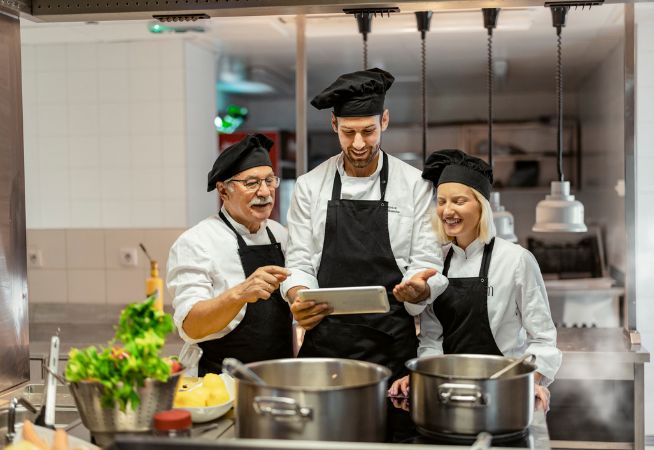01 April 2024
4

Did you know restaurants are poised to become the next trillion-dollar industry?
With sales projected to surpass a trillion dollars for the first time in history this year, restaurants everywhere are ready for growth and preparing for increased demand. Higher demand, however, comes with a price—it also means restaurants will face rising costs, more complicated operational challenges, and increased demand for skilled employees amid a fierce war for talent.
Restaurants are all too familiar with the significant costs associated with employee churn, especially with turnover rates up to 1.5 times higher than other industries. In such high turnover environments, restaurants must get new employees trained quickly and efficiently so they can get started on the job as soon as possible. Employees must also know how to follow brand and operational standards to ensure quality control, especially at establishments with national and international reputations to protect.
Continuous workplace learning and development helps restaurants scale, meet demand, and ensure consistent and high-quality food service at every location. Here are ten essential considerations for fast casual, quick-service, and fine dining restaurants looking for a learning platform to transform their L&D efforts.
A Configurable Platform
Restaurants—especially franchises—are complex organizations that often encompass multiple brands or business units. Operations may also vary greatly depending on state, country, or region. Even at smaller companies, various team members’ roles and responsibilities can vastly differ from another restaurant. That means restaurants need a learning solution that’s flexible, adaptable, and built to scale. Customizing job roles, reporting structures, user permissions, branding, personalized learning experiences, and more to reflect how your restaurant does business should be simple.
Mobile Learning
Most restaurant employees are on their feet all day rather than at desks with computers. Furthermore, using computers connected to point-of-sale systems or other technology for training would present serious security risks. Mobile learning is an ideal solution for restaurants because it makes training accessible via devices employees are already comfortable using, and it gives them access to valuable training resources within the flow of work right when they need the information. When learning is optimized for mobile, it’s also more engaging and effective, making it more likely that the knowledge will stick and employees will return for further training.
On-Demand Content
Anyone who’s worked in the restaurant industry knows the hours are rough. Employees are much more likely to complete training if it’s mobile-first and on-demand. Personalized content suggestions, learning paths, games, and video-based microlearning go a long way in encouraging learners to engage with the resources available to them and continuously improve their skills. A best practice is to keep training content short (under five minutes long) for maximum impact, making it easier for learners to retain the information.
On-the-Job Training
Online coursework is ideal for compliance courses, leadership training, and personal development, but some things are better taught in person. Even if online materials are available for reference, most employees benefit from live demonstrations of food and beverage preparation, dishwashing, table setting, and other high-touch tasks.
Compliance Training and Verification
Beyond your specific food builds, guidelines, and operations, restaurants often need to ensure employees complete mandated training around food safety, food service, alcohol service, and more in accordance with local, state, and federal laws. Choosing a learning technology provider with a strong network of content partners to source industry-standard materials for ServSafe training, TIPS certification, and similar content needs is always a good idea. You’ll also want a platform that makes it a breeze to track employee training activity, automate assignments and reminders, collect e-signatures upon completion, and generate reports to verify compliance.
Course-Building Tools
Most employees will need specialized training in multiple areas, so it’s crucial to organize training well so they can handle the influx of information. L&D leaders need an LMS that simplifies the course-building process with tools like drag-and-drop, automated assignments, classroom management, and AI-powered skills mapping.
Powerful Reporting
Once you have training activity, you’ll have a lot of data. Choosing a platform that helps make sense of all that data in a valuable, insightful way is essential. Select a platform with pre-built templates that lets you customize your templates if needed. And when reports are ready, you’ll want an LMS that automatically delivers them directly to the inboxes of everyone who needs them. For large organizations, it’s often best to schedule reports to be generated and delivered to key stakeholders.
Social Learning and Gamification
Data from the National Restaurant Association shows restaurants employ more young people than other industries, with about 37% of all its employees under 25.
Restaurants must design learning that primarily—and necessarily—appeals to younger employees. Internet-native generations prefer learning experiences that mimic their favorite media and gaming apps over tedious learning that resembles schoolwork. If learning feels like a chore, these employees won’t engage, and the dollars spent on training resources can go to waste. More critically, restaurant operations can suffer, and customer satisfaction can suffer.
Talent Development
The National Restaurant Association estimates the average restaurant loses up to $150K annually in staff turnover alone. That figure is likely many times higher for multinational franchises with hundreds or thousands of locations.
Many restaurant professionals leave their jobs when they sense a lack of career growth opportunities. Restaurants that provide a better employee experience—including personal and professional development opportunities—are more likely to retain employees long-term. Over time, robust training can reduce employee turnover by up to 35%.
Coaching
While a stepping stone for many, millions of restaurant professionals seek to establish a stable career in the industry. Like any other business, restaurants benefit from investing in their people and equipping them with the skills they need to take on greater responsibility within the organization. A learning platform with coaching capabilities empowers managers, mentors, and employees to connect regularly for more meaningful conversations and knowledge sharing. These one-on-one interactions are designed to go deeper than typical training sessions and can help organizations unlock immense talent that can drive the business forward.
Ready to explore the future of learning? Say hello to Schoox at the Restaurants Canada Show in Toronto on April 8, and be sure to catch us at ATD2024 in New Orleans for something big.
RELATED RESOURCES


